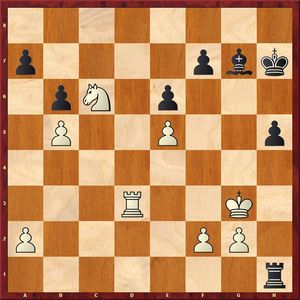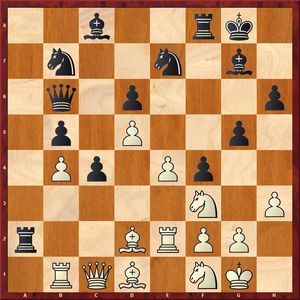17 September 2015
The Italian Version of the Cat-and-Mouse Game
Round 11 of the Junior World Chess Championship reviewed by IM Vladimir Barsky.
A quiet draw was made by the tournament leader Jan-Krzysztof Duda as Black against the German junior Matthias Bluebaum, whereas Francesco Rambaldi (Italy) and Mikhail Antipov (Russia) have come to reduce their trailing gap behind the leader to only half a point.
Rambaldi – Bajarani
Black handled the opening in a very risky style and had to part ways with an exchange. Then a cat and mouse game started with the engine evaluating White’s advantage to as many as “+10” from time to time, although Francesco would somehow fail to come up with a decisive blow.

It is high time that the second front on the queenside be opened: 33.Rxb4! axb4 34.g7+ Ke8 35.Qxb4 Qe7 36.Qb6!, and Black is helpless against the Bg6+ threat; e.g.: 36…fxe5 37.Bg6+ Kd7 38.Qxb7+ followed by 39.Qxa8.
33.Qh7 Qg7 34.Nf3 b6 35.Rg4 Bd7 36.Rh4 Rd8 37.Nd4
Francesco acts in a too straightforward a manner, trying to break through the center, whereas he needed to direct his attention to the queenside once again: 37.c3! Bc5 (there is no way that the b6-pawn can be surrendered) 38.Qxg7+ Kxg7 39.Rh7+ Kf8 40.Bb5!, and once the light-squared bishops disappear from the board there is just going to be no one there to stop the passed h-pawn from rolling forward.
37...f5 38.Bb5 Bxb5+ 39.Nxb5 Rd7 40.Nd4 Rd6 41.c3 Bc5 42.Re1 Bxd4 43.cxd4 Rc6 44.Qh5 Ne7 45.Qg5 Qxg6 46.Qf4
There was a spectacular way to win the game in this position: 46.Rh8+ Kg7 47.Qh4 f4 48.Rh6! Qxh6 49.Qxe7+ Kg6 50.Qe8+.
46...Qg7 47.Rh5 Kf7 48.Qh4 Ng6 49.Qg3 Nf8?
The Azerbaijani grandmaster has been defending with a lot of imagination and after 49...b5! 50.Qb8 Kf6 could have obtained a real chance to bail out. White cannot take the pawn (51.Qxb5? Nf4), and while no direct ways to improve the position are within sight, Black has already started to feature a definite amount of counterplay. At this moment, however, Ulvi missed a relatively primitive blow.

50.Rxf5+! exf5 51.Re7+ Kxe7 52.Qxg7+ Ke8 53.Qe5+ Ne6 54.h4, and Black resigned shortly after.
Antipov – Chigaev
This is the Russian derby on the third table. In this approximately equal position Mikhail Antipov has handled his pieces in a shrewder manner to outplay his opponent.

Black can win a pawn here via 28...f6 29.Qc2 fxe5, but after 30.Nd2 White features good counterplay due to better command over the light squares coupled with the fact that the black king is somewhat vulnerable. However, another curious maneuver – 28...Na6!? – was at the disposal of Maxim Chigaev. Should the queens be traded, the Black’s chances would start to look preferable as White needs a couple of tempi to redirect his rook back into the battlefield theatre. Should the queen retreat via 29.Qb2, after 29…Nb8 the knight is allowed to reach the d7-square in a somewhat roundabout way to put additional pressure on the e5-pawn.
28...Qb8
This move was played with the same idea of installing the knight on the d7-square. However, White can also make use of a newly-born possibility to improve the location of his pieces.
29.Bc4 Rd1+ 30.Kh2 Qd8 31.Qe3 Qc7
A waiting move of the 31…Kf8 type was worthy of paying attention to in order to prevent the white knight from being activated.
32.Nd4 Qd8 33.Nc6
Objectively speaking, the position remains within the realms of rough equality, but Antipov avoids the repetition of moves via 33.Nf3.
33…Qd2 34.Rh3 Qc2 35.Rh4 Qb1 36.Rd4
While no serious threats to the white king on h2 can be further created, White has capitalized on the opportunity to return his rook into the center to take possession of the open file. Antipov has been slowly accumulating the positional “pluses”.
36…Rh1+ 37.Kg3 h5 38.Bd3 Nxd3?!
This is perhaps the first inaccuracy of a serious magnitude. The active knight should have been preserved from trading and 38...Qc1 be played.
39.Rd8+ Kh7 40.Qe4+ Kh6 41.Qe3+ Kh7 42.Qxd3+ Qxd3+ 43.Rxd3

43…Rb1?!
This is the wrong object to attack as the e5-pawn is of a lot more significant value! After 43...Kg6! 44.Rd7 Re1 45.Ne7+ Kh7 46.f4 Bh6! Black features sufficient counterplay. After this move Antipov starts to outperform his opponent in a technical style.
44.a4 Bf8 45.Rd7 Kg6 46.Nd8!
Black must have counted on 46.Rxa7 Bc5 47.Nd8 Bd4 48.Nxf7 Kf5!, and despite being two pawns down he has excellent counter chances. The move in the game is a lot more unpleasant for him.
46...Rb3+?
This is a decisive mistake. 46...Rf1! 47.Rxf7 Bg7 48.Rxa7 Bxe5+ 49.Kf3 h4 would have been a great deal more stubborn to provide Black with reasonable chances of saving the game.
47.f3 Bb4 48.Rxf7 Be1+ 49.Kh3 Rb4 50.g3 h4
50...Rxa4 51.Rf6+ Kh7 52.Nxe6 fails to help either.
51.Rf6+ Kh7 52.Rf4 Black resigns.
Goryachkina – Bogdanov

Following a bad break at the start of the tournament, Aleksandra Goryachkina has once again made her fans happy. The Russian Champion used an offbeat approach against the King’s Indian Defence to gain a sizeable material advantage. Her opponent plunged into the banzai attack, but Aleksandra repelled all invasions in a cold-blooded fashion.
29.Bd2! Qh2+ 30.Kd3! Ne5+ 31.Kc2 Qe2 32.Rad1 Ba6 33.Qxc7+ Kg6 34.Qxd6+ Bf6 35.Rge1 Bd3+ 36.Kc1 Qg2 37.c7 Be4 38.Qxe5! Black resigns.
In the women's tournament Zhansaya Abdumalik suffered her second defeat in a row, overlooking a powerful blow delivered by her opponent.
Abdumalik – Derakhshani

The Iranian opted for the Janisch gambit as a means of preparation for such an important game and, having left her king in the center, started piling up threats on the kingside. Zhansaya could have traded queens to secure herself against all possible threats; however after 30.Qg2 Qxg2+ 31.Kxg2 White features nothing else but a slight symbolic space advantage. On the other hand, the shortcomings of Black’s structure could have been underlined by a prophylactic maneuver 30.Qf2! Raf8 31.Rfb1!, after which the Black’s assault hits a dead-end because the g5-g4 advance (immediately or after the rook sacrifice on f3) runs into 32.Bf1, resulting in the queen being trapped.
Should Black meet 30.Qf2! with the immediate 30...g4, then after 31.f4! exf4 (31...Nxf4 32.gxf4 Rxf4 33.Qg3 would be bad as well) 32.e5! it is White who is the first to launch his attack, which proves to be extremely dangerous.
30.Rf2?! g4! 31.f4 Nxg3!
A superb solution! Black gets only two pawns for the knight at the moment, but is going to grab a third and a forth ones in a short while... However, the most important thing is that he starts to enjoy an easy type of play.
32.hxg3 Qxg3+ 33.Rg2 Qc3 34.Re1 Rxf4 35.Qe3 Qxb4 36.Rb1 Qxa5 37.Rxb7 Qa1+ 38.Kh2 Qd4 39.Qg3 Raf8 40.Qh4+?!
This is a fresh inaccuracy committed on the time control move. The immediate 40.Qb3 fails to 40…Rf2; however, 40.Be2! h5 allowed to stay in the game (the knight cannot be captured in view of 40…Qxd2? 41.Rxd7+!) 41.Qh4+ R8f6 42.Qg5 or even a more subtle move 40.Kh1! (the idea behind the move being that after Rf2 the capture on g2 is done without checking, which gains White an important tempo to launch his own counterplay) 40…R8f6 41.Qb3 h5 42.Rxd7+! with a draw.
40...R8f6 41.Be2 Kd8 42.Ba6 Rf2

43.Nf1?
Once again the cute 43.Kh1! retreat would have helped White out, e.g.: 43…Qe3 44.Rxf2 Qxf2 45.Qxf2 Rxf2 (a capture without checking!) 46.Nc4 Ra2 47.Nb6 Be8 (or 47...Rxa6 48.Rxd7+ Ke8 49.Rb7) 48.Rb8+ Ke7 49.Nc8+ Kf6 50.Bc4 Rd2 51.Nxd6 – and White manages to hold the equilibrium.
43...Rxg2+ 44.Kxg2 Qxe4+ 45.Kg1 Qd4+ 46.Kg2 Qf4 47.Rb2 Ke7 48.Rf2 Qxf2+ 49.Qxf2 Rxf2+ 50.Kxf2 d5
Five pawns is just too many for a single knight to cope with.
51.Kg3 Kf6 52.Nd2 Kg5 53.Nb3 h5 54.Nc5 h4+ 55.Kg2 Bf5 56.Bb7 Be4+

57.Kh2
In the case of 57.Nxe4+ dxe4 58.Bxc6 Kf4 Black is also winning without having to go through a lot of difficulties, e.g.: 59.Bb5 e3 60.Be2 h3+ 61.Kh2 e4 62.Bd1 g3+ 63.Kxh3 e2 64.Bxe2 Ke3 65.Bf1 Kf2 66.Bg2 e3 – and one of the pawns is going to queen inevitably.
57...g3+ 58.Kh3 Bf5+ 59.Kg2 Kg4 60.Bxc6 h3+ 61.Kg1 d4 62.Nb3 d3 63.Nd2 Kf4 64.Nc4 e4 65.Nb6 Be6 66.Na4 e3 67.Nb2 Bf5 White resigns.
Ziaziulkina – Bivol

Although Alina Bivol has emerged advantageous out of the opening, she went on to miss a simple yet quite a cute tactical trick. After the precise 23...Qa6! White is unable to play 24.Bc3 because after 24…Bxc3 25.Qxc3 Ra3 26.Qc2 Bxh3! she loses her pawn.
23…Re8? 24.Be3! fxe3
White has to part with an exchange since after 24...Qa6 25.Rxa2 Qxa2 26.Bd4 (threatening to trap the queen) 26…Bxd4 27.Nxd4 Qa6 28.Ra1 Qb6 29.Qc3 Black’s position is just extremely bad.
25.Rxa2 exf2+ 26.Rxf2 Ng6 27.Bc2 Nf4 28.Qe3
This is a sound practical approach: White gives away one of her pawns in order to exchange queens.
28…Nxd5 29.Qxb6 Nxb6 30.Ne3 Be6 31.Rd2

31…c3?!
The pawn had better be left as is, although after the exemplary sequence of moves 31...Bc3 32.Rdd1 Bd7 33.Nd4 White’s game is a lot simpler to play as she is being up an exchange sacrifice after all. It should be noted, however, that Black’s chances to make a draw would have remained considerably high and she just needed to adequately employ her knights.
32.Rdd1 Nc4 33.Nxc4 Bxc4 34.Ra1 Rb8 35.Nd4 Nd8 36.Ra6 Bxd4+ 37.Rxd4 Nf7 38.Ra3
The c3-pawn drops, and White’s position becomes technically won.

38…Kf8 39.Rxc3 Ra8 40.Rd1 Ke7 41.Bd3 Ne5 42.Bxc4 Nxc4 43.Rd5 Ra1+ 44.Kh2 Rb1 45.e5 dxe5 46.Rxb5 Nd2 47.Rc6 Nf1+ 48.Kg1 Ng3+ 49.Kf2 Ne4+ 50.Ke3 Nd6 51.Rbb6 Rb3+ 52.Kd2 Ne4+ 53.Kc2 Rg3 54.Rb7+ Kd8 55.Rxh6 Black resigns.
The tournament leader Nataliya Buksa (Ukraine) made a draw with the Russian player Alexandra Makarenko and is now a whole point ahead of Zhansaya Abdumalik (Kazakhstan) and Nastassia Ziaziulkina (Belarus). There are still two all-important rounds left to go, though.





















